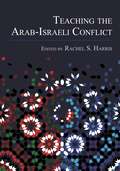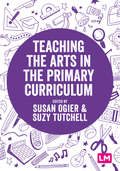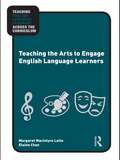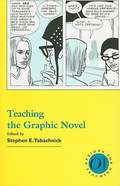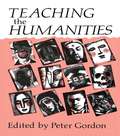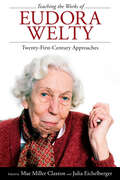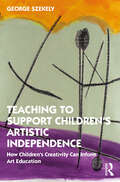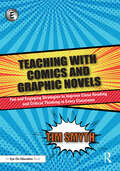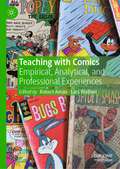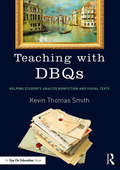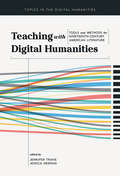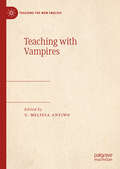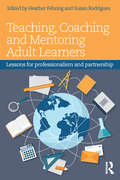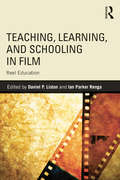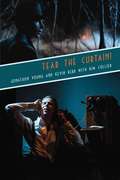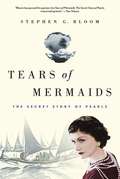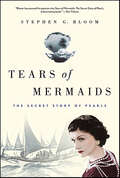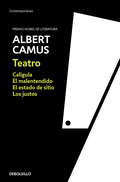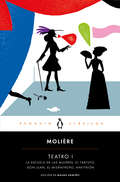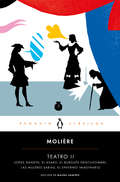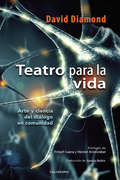- Table View
- List View
Teaching the Arab-Israeli Conflict
by Cary Nelson Peter C. Herman Alan Dowty P. R. Kumaraswamy Joel S. Migdal Liora R. Halperin Philip Metres Caitlin Carenen Jacob Lassner Shiri Goren Rachel S. Harris Ranen Omer-Sherman Amy Weiss Mira Sucharov Umut Uzer Janice W. Fernheimer Martin Shichtman Ashley Passmore Dr Donna R. Divine Adia Mendelson-Maoz Marcela Sulak Ellen W. Kaplan Beverly Bailis Marilyn R. Tayler Randall G. Rogan Oren Kroll-Zeldin Russell A. Berman Shayna Weiss Olga Gershenson Holli Levitsky Terri Susan Fine Husam Mohamad Menna Abukhadra Rachel Feldhay Brenner Jeffrey Bloodworth Ari Ariel Mya Guarnieri Jaradat Susan Jacobowitz Rolin G. Mainuddin Randy DeshazoThe Arab-Israeli conflict has become a touchstone of international politics and a flash point on college campuses. And yet, how do faculty teach such a contentious topic in class? Taught not only in international relations, peace and conflict resolution, politics and history, and Israel and Middle Eastern studies courses but also in literature, sociology, urban planning, law, cinema, fine art, and business—the subject guarantees wide interest among students. Faculty are challenged to deal with the subject’s complexity and the sensitive dynamics it creates. The result is anxiety as they approach the task and a need for guidance. Teaching the Arab-Israeli Conflict edited by Rachel S. Harris is the first book designed to meet this need. Teaching the Arab-Israeli Conflict brings together thirty-nine essays from experienced educators who reflect on the challenges of engaging students in college classrooms. Divided into seven sections, these personal essays cover a broad range of institutional and geographical settings, as well as a wide number of academic disciplines. Some of the topics include using graphic novels and memoirs to wrestle with the complexities of Israel/Palestine, the perils of misreading in the creative writing classroom as border crossing, teaching competing narratives through film, using food to teach the Arab-Israeli conflict, and teaching the subject in the community college classroom. Each essay includes suggestions for class activities, resources, and approaches to effective teaching. Whether planning a new course or searching for new teaching ideas, this collection is an indispensable compendium for anyone teaching the Arab-Israeli conflict.
Teaching the Arts
by William Baker Amy Hamilton David RoyTeaching the Arts: Early Childhood and Primary Education provides a comprehensive and exciting introduction to Arts education in Australia and New Zealand. By illustrating the fundamental links between theory and practice, this book equips students with the skills and knowledge to teach the Arts. The book covers each of the five Arts strands -dance, drama, media arts, music and visual arts - in detail. Each chapter encourages readers to engage with the Arts and provides opportunities to develop understanding and practical skills through reflective questions, examples and activities. Teaching the Arts draws important links to the Australian Curriculum, the New Zealand Curriculum, the Early Years Learning Framework and TeWhariki, and includes substantial references to Indigenous histories and cultures, relationships with Asia, and sustainability. Generously illustrated and featuring excellent on-line resources, Teaching the Arts is an indispensable resource for pre-service teachers.
Teaching the Arts
by William Baker David Roy William Baker Amy Hamilton David RoyTeaching the Arts: Early Childhood and Primary Education provides a comprehensive and exciting introduction to Arts education in Australia and New Zealand. By illustrating the fundamental links between theory and practice, this book equips students with the skills and knowledge to teach the Arts. The book covers each of the five Arts strands -dance, drama, media arts, music and visual arts - in detail. Each chapter encourages readers to engage with the Arts and provides opportunities to develop understanding and practical skills through reflective questions, examples and activities. Teaching the Arts draws important links to the Australian Curriculum, the New Zealand Curriculum, the Early Years Learning Framework and TeWhariki, and includes substantial references to Indigenous histories and cultures, relationships with Asia, and sustainability. Generously illustrated and featuring excellent on-line resources, Teaching the Arts is an indispensable resource for pre-service teachers.
Teaching the Arts in the Primary Curriculum (Exploring the Primary Curriculum)
by Suzy Tutchell Susan OgierLearning in the arts does not fit in with simple, conventional methodologies for teaching and assessing in the traditional sense, but it has an immense power to transform children’s understanding of the world around them, and their lives. Many jobs, currently and of the future, will demand the skills that learning in the arts will develop. This book brings Arts Education sharply into focus as a meaningful, learning experience for children of pre-school and primary age (3-11 years). It reinforces the potential for the wide range of physical, mental and emotional development, through learning opportunities that engagement in arts practice facilitates. Provides insight into how teachers can support children to consider contemporary challenges that face their generation. Includes expert voices from the world of education to demonstrate an expansive, and perhaps surprising, view of where and how the Arts can be found. Shows how we can bring the arts so easily into our curriculum, and into our classrooms.
Teaching the Arts in the Primary Curriculum (Exploring the Primary Curriculum)
by Suzy Tutchell Susan OgierLearning in the arts does not fit in with simple, conventional methodologies for teaching and assessing in the traditional sense, but it has an immense power to transform children’s understanding of the world around them, and their lives. Many jobs, currently and of the future, will demand the skills that learning in the arts will develop. This book brings Arts Education sharply into focus as a meaningful, learning experience for children of pre-school and primary age (3-11 years). It reinforces the potential for the wide range of physical, mental and emotional development, through learning opportunities that engagement in arts practice facilitates. Provides insight into how teachers can support children to consider contemporary challenges that face their generation. Includes expert voices from the world of education to demonstrate an expansive, and perhaps surprising, view of where and how the Arts can be found. Shows how we can bring the arts so easily into our curriculum, and into our classrooms.
Teaching the Arts to Engage English Language Learners
by Margaret Macintyre Latta Elaine ChanWritten for prospective and practicing visual arts, music, drama, and dance educators, Teaching the Arts to Engage English Language Learners offers guidance for engaging ELLs, alongside all learners, through artistic thinking. By paying equal attention to visual art, music, drama, and dance education, this book articulates how arts classrooms can create rich and supportive contexts for ELLs to grow socially, academically, and personally. The making and relating, perceiving and responding, and connecting and understanding processes of artistic thinking, create the terrain for rich curricular experiences. These processes also create the much-needed spaces for ELLs to gain communicative practice, skill, and confidence. Special features include generative texts such as films, poems, and performances that function as springboards for arts educators to adapt according to the needs of their classroom; teaching tips, formative assessment practices, and related instructional tables and resources; an annotated list of internet sites, reader-friendly research articles, and instructional materials; and a glossary for readers’ reference.
Teaching the Eighteenth Century Now: Pedagogy as Ethical Engagement (Transits: Literature, Thought & Culture, 1650-1850)
by Kate Parker Tiffany Potter Diana Epelbaum Teri Doerksen Ziona Kocher Christine D. Myers Matthew L. Reznicek Travis Chi Lau Emily C. Casey Eugenia ZuroskiIn this timely collection, teacher-scholars of “the long eighteenth century,” a Eurocentric time frame from about 1680 to 1832, consider what teaching means in this historical moment: one of attacks on education, a global contagion, and a reckoning with centuries of trauma experienced by Black, Indigenous, and immigrant peoples. Taking up this challenge, each essay highlights the intellectual labor of the classroom, linking textual and cultural materials that fascinate us as researchers with pedagogical approaches that engage contemporary students. Some essays offer practical models for teaching through editing, sensory experience, dialogue, or collaborative projects. Others reframe familiar texts and topics through contemporary approaches, such as the health humanities, disability studies, and decolonial teaching. Throughout, authors reflect on what it is that we do when we teach—how our pedagogies can be more meaningful, more impactful, and more relevant. Published by Bucknell University Press. Distributed worldwide by Rutgers University Press.
Teaching the Graphic Novel
by Stephen E. TabachnickGraphic novels are now appearing in a great variety of courses: composition, literature, drama, popular culture, travel, art, translation. The thirty-four essays in this volume explore issues that the new art form has posed for teachers at the university level.
Teaching the Humanities
by Peter GordonFirst Published in 1991. Routledge is an imprint of Taylor & Francis, an informa company.
Teaching the Works of Eudora Welty: Twenty-First-Century Approaches
by Mae Miller Claxton and Julia EichelbergerContributions by Jacob Agner, Sharon Deykin Baris, Carolyn J. Brown, Lee Anne Bryan, Keith Cartwright, Stuart Christie, Mae Miller Claxton, Virginia Ottley Craighill, David A. Davis, Susan V. Donaldson, Julia Eichelberger, Kevin Eyster, Dolores Flores-Silva, Sarah Gilbreath Ford, Stephen M. Fuller, Dawn Gilchrist, Rebecca L. Harrison, Casey Kayser, Michael Kreyling, Ebony Lumumba, Suzanne Marrs, Pearl Amelia McHaney, David McWhirter, Laura Sloan Patterson, Harriet Pollack, Gary Richards, Christin Marie Taylor, Annette Trefzer, Alec Valentine, Adrienne Akins Warfield, Keri Watson, and Amy WeldonToo often Eudora Welty is known to the general public as Miss Welty, a "perfect lady" who wrote affectionate portraits of her home region. Yet recent scholarship has amply demonstrated a richer complexity. Welty was an innovative artist with cosmopolitan sensibilities and progressive politics, a woman who maintained close friendships with artists and intellectuals throughout the world, a writer as unafraid to experiment as she was to level her pen at the worst human foibles.The essays collected in Teaching the Works of Eudora Welty seek to move Welty beyond a discussion of region and reflect new scholarship that remaps her work onto a larger canvas. The book offers ways to help twenty-first-century readers navigate Welty's challenging and intricate narratives. It provides answers to questions many teachers will have: Why should I study a writer who documents white privilege? Why should I give this "regional" writer space on an already crowded syllabus? Why should I teach Welty if I do not study the South? How can I help my students make sense of her modernist narratives? How can Welty's texts help me teach my students about literary theory, about gender and disability, about cultures and societies with which my students are unfamiliar?
Teaching to Support Children's Artistic Independence: How Children's Creativity Can Inform Art Education
by George SzekelyThis engagingly written, research- and practice-based book defines how art teachers can build on students’ creative initiatives without depending on adult-imposed lesson plans and school requirements. In doing so, art educator and author George Szekely explores the role of the arts in developing children’s creativity and sense of purpose, and reminds readers that students in the art classroom are unique artists, designers, and innovators. Against the backdrop of a school culture that over-emphasizes compliance and standardization, Szekely recognizes the importance of the role of the art teacher in supporting the artistic independence and creative flare that occurs naturally in students of all ages in the classroom. Providing real-life examples of classrooms and schools that work towards championing child artists, this text arms teachers with the skills necessary to listen to their students and support them in presenting their ideas in class. Ultimately, Szekely challenges readers to focus the practice of art teaching on the student’s creative process, rather than the teacher’s presentation of art. Written for pre-service and in-service art educators, teacher educators, and researchers, Teaching to Support Children’s Creativity and Artistic Independence demonstrates that an openness to youthful and inquisitive visual expression inspires a more rewarding learning experience for both teacher and child artists that can support a life-long love of art.
Teaching with Comics and Graphic Novels: Fun and Engaging Strategies to Improve Close Reading and Critical Thinking in Every Classroom
by Tim Smyth35th Annual Will Eisner Comic Industry Awards Nominee! This text will allow you to harness students’ love of comics and graphic novels while increasing critical thinking and engagement in the classroom. Author Tim Smyth offers a wide variety of lessons and ideas for using comics to teach close reading, working with textual evidence, literature adaptations, symbolism and culture, sequencing, essay writing, and more. He also models how to use comics to tackle tough topics and enhance social-emotional learning. Throughout the book, you’ll find a multitude of practical resources, including a variety of lesson plans—some quick and easy activities as well as more detailed ready-to-use unit plans. These thoughtful lessons meet the Common Core State Standards and are easy to adapt for any subject area or grade level to fit into your curriculum. Add this book to your professional library and you’ll have a new and exciting way of reaching and teaching your students!
Teaching with Comics: Empirical, Analytical, and Professional Experiences
by Robert Aman Lars WallnerThis edited collection analyses the use of comics in primary and secondary education. The editors and contributors draw together global research to examine how comics can be used for critical inquiry within schools, and how they can be used within specific disciplines. As comics are beginning to be recognised more widely as an important resource for teaching, with a huge breadth of topics and styles, this interdisciplinary book unites a variety of research to analyse how learning is 'done' with and through comics. The book will be of interest to educational practitioners and school teachers, as well as students and scholars of comic studies, education and social sciences more broadly.
Teaching with DBQs: Helping Students Analyze Nonfiction and Visual Texts
by Kevin Thomas SmithHelp your students navigate complex texts in history and social studies. This book shows you how to use document-based questions, or DBQs, to build student literacy and critical thinking skills while meeting rigorous state standards and preparing students for AP exams. DBQs can be implemented year-round and can be adjusted to meet your instructional needs. With the helpful advice in this book, you’ll learn how to use DBQs to teach nonfiction and visual texts, including primary and secondary sources, maps, and paintings. You’ll also get ideas for teaching students to examine different points of view and write analytical responses. Topics include: Using the SOAPSETone (Speaker, Occasion, Audience, Purpose, Subject, Evidence and Tone) technique to to analyze visual and nonvisual texts; Teaching students to distinguish between primary and secondary sources; Working with multiple texts and learning to recognize the relationships between them; Formulating DBQs to suit different types of assessment, including short-answer questions, multiple-choice questions, and in-class essay prompts; Evaluating student responses and providing constructive feedback.
Teaching with Digital Humanities: Tools and Methods for Nineteenth-Century American Literature (Topics in the Digital Humanities)
by Jennifer Travis Jessica DeSpainJennifer Travis and Jessica DeSpain present a long-overdue collection of theoretical perspectives and case studies aimed at teaching nineteenth-century American literature using digital humanities tools and methods. Scholars foundational to the development of digital humanities join educators who have made digital methods central to their practices. Together they discuss and illustrate how digital pedagogies deepen student learning. The collection's innovative approach allows the works to be read in any order. Dividing the essays into five sections, Travis and DeSpain curate conversations on the value of project-based, collaborative learning; examples of real-world assignments where students combine close, collaborative, and computational reading; how digital humanities aids in the consideration of marginal texts; the ways in which an ethics of care can help students organize artifacts; and how an activist approach affects debates central to the study of difference in the nineteenth century.
Teaching with Vampires (Teaching the New English)
by U. Melissa AnyiwoThis edited volume provides pedagogical tools for those who teach – and would like to teach – with the most iconic of monsters: the vampire. Vampires are showing up with increasing frequency in the college classroom and there are a growing number of courses devoted solely to the Undead. This collection draws from a diverse range of teaching approaches, including the theoretical framing of vampire texts in a broad range of settings, that demonstrate the myriad of ways vampires are used to teach about marginalization, empathy, and inspire social justice. With chapters from global scholars, this essential text illustrates the burgeoning field of vampire studies and the popularity in classrooms at every level around the world, from gothic fiction to television courses.
Teaching, Coaching and Mentoring Adult Learners: Lessons for professionalism and partnership
by Heather Fehring Susan RodriguesThe challenge for those coaching, mentoring, supervising or teaching adults is to design and deliver high-quality programmes that encompass a blend of teaching and learning approaches and strategies, that are constructed for adult learners in multiple educational environments and that cater for the diversity of adult learners’ needs. Adult learners are complex individuals who come to the learning process with a multitude of different experiences. Teaching, Coaching and Mentoring Adult Learners helps practitioners step up to this challenge by developing the skills needed to share their expertise with adult learners and engage them in new transformative practices. This book also forms a timely contribution to the current period of evolution in adult education, where extreme changes in the nature and scope of work and the globalisation of work and life are influencing learning. The shift in adult education addressed in this book includes: the globalisation of the workforce and the cultural impact on adult, tertiary and further education the relationship established between adult educators and adult learners provision of adult education and professional development by private and major multimedia and corporate interests occupations boundaries between professions and between skilled and unskilled work assessing adult learners’ needs and adapting strategies to meet the perceived needs of adult learners in medicine, education, psychology and industry designing learning experiences to maximise the processing of complex conceptual knowledge and then transforming the knowledge to fit new learning environments the role of new technologies of learning in adult and vocational learning. This book provides research-based insight into the expectations and the value of the coach, mentor, tutor and supervisor roles and combines research with strategic guidance to support the implementation of innovative techniques through case studies, strategies and methodologies in teaching and learning in higher education and professional learning. Bringing together insights from an expert range of international contributors, this text will be invaluable to higher education professionals and those involved in supervising, coaching and mentoring in the workforce.
Teaching, Learning, and Schooling in Film: Reel Education
by Ian Renga Daniel ListonFilms about education provide many of the most popular interpretations of what teaching and learning mean in schools. An analysis of this medium reveals much about the historical, cultural, political, and philosophical dimensions of education. Timely and engaging, this book fills a gap for scholarly and informed public commentary on the portrayal of education in film, offering a wide range of conceptual and interpretive perspectives. Teaching, Learning, and Schooling in Film explores several key questions, including: What does it mean to be a good teacher? How do these good teachers instruct? When is and what makes teaching complex? What constitutes learning? Do educational reforms work? The book’s interdisciplinary group of contributors answers these important questions in essays highlighting Hollywood, independent, and documentary films. Prospective and practicing teachers will engage with the thought-provoking educational issues raised in this book and gain insight into the complexities of teaching and learning portrayed in film.
Tear the Curtain!
by Jonathon Young Kim Collier Kevin KerrIn this psychological thriller set in a fictionalized 1930s Vancouver, Alex Braithwaite, a troubled but passionate theatre critic, believes he has found the legendary Stanley Lee, director of the infamous avant-garde theatre "The Empty Space." Alex becomes convinced that this man's radically subversive ideas are what the artistic community of the city needs to shatter audience complacency. In his pursuit of the truth behind Stanley Lee's mysterious disappearance and his artistic ideas, Alex becomes caught between the warring factions of two prominent mob families - one controlling the city's playhouses, the other its cinemas, but both ensnared by the Empty Space Society. At the dawn of the Talkies, can Alex tear through the artifice of these art forms in time to save the city's art community from ripping itself apart?The play's collaborators found inspiration within the walls of Vancouver's Stanley Theatre, a space that has a dual history as a cinema and vaudeville house. Fittingly, this gritty film-noir production became an exploration of the two kinds of art and how they affect the audience. Tear the Curtain! explores global issues that consider what we want from art: to be shocked and surprised or for order to be restored.Cast of 2 women and 8 men.
Tears of Mermaids: The Secret Story of Pearls
by Stephen G. BloomA round, luminescent pearl is the simplest and most perfect gem. Columbus sought-and found-this precious jewel coveted by his Spanish sovereigns, sparking popularity throughout Europe. Fashion icons Jacqueline Kennedy, Princess Grace, and Michelle Obama cherished them, making them iconic. And designer Coco Chanel raised them to new heights, bringing pearls- fake and real-to women everywhere. In Tears of Mermaids, Stephen G. Bloom travels 30,000 miles in an effort to trace a single pearl-from the moment a diver off the coast of Australia scoops an oyster containing a single luminescent pearl from the ocean floor to the instant a woman fastens the clasp of a strand containing the same or Bloom chronicles the never-before-told saga of the global pearl trade by gaining access to clandestine outposts in China, the Philippines, French Polynesia and Australia. He infiltrates high-tech pearl farms guarded by gun-toting sentries, farms for pearls in rural China, and even goes backstage at Christie's for a fast and furious auction of the most expensive pearl ever sold. Teeming with rogue humor and uncanny intelligence, Tears of Mermaids weaves a nonstop detective story whose main character is the world's most enduring jewel.
Tears of Mermaids: The Secret Story of Pearls
by Stephen G. BloomA round, luminescent pearl is the simplest and most perfect gem. Columbus sought—and found—this precious jewel coveted by his Spanish sovereigns, sparking popularity throughout Europe. Fashion icons Jacqueline Kennedy, Princess Grace, and Michelle Obama cherished them, making them iconic. And designer Coco Chanel raised them to new heights, bringing pearls— fake and real—to women everywhere. In Tears of Mermaids, Stephen G. Bloom travels 30,000 miles in an effort to trace a single pearl—from the moment a diver off the coast of Australia scoops an oyster containing a single luminescent pearl from the ocean floor to the instant a woman fastens the clasp of a strand containing the same orb. Bloom chronicles the never-before-told saga of the global pearl trade by gaining access to clandestine outposts in China, the Philippines, French Polynesia and Australia. He infiltrates high-tech pearl farms guarded by gun-toting sentries, farms for pearls in rural China, and even goes backstage at Christie's for a fast and furious auction of the most expensive pearl ever sold. Teeming with rogue humor and uncanny intelligence, Tears of Mermaids weaves a nonstop detective story whose main character is the world's most enduring jewel.
Teatro
by Albert CamusLa cuatro grandes obras de teatro originales de Albert Camus reunidas en un solo volumen, con un prólogo inédito del autor El presente volumen reúne las cuatro obras de teatro originales de Albert Camus: El malentendido (1944), Calígula (1945), El estado de sitio (1948) y Los justos (1949). Todas pertenecen a lo que podría llamarse el teatro moral o de ideas, relacionado formal y temáticamente con la tragedia clásica, a la que el autor era muy afecto. Sus temas y ambientes abarcan desde el sino trágico de una familia en plena Segunda Guerra Mundial hasta los ataques terroristas de un grupo de revolucionarios rusos, pasando por un brote de peste en una Cádiz imaginaria, o una recreación histórica de los excesos del tirano romano Calígula. Pero Camus sabía que al reflejar momentos históricos todo artista acaba hablando del presente. Así pues, en estas obras escritas a caballo de la Segunda Guerra Mundial encontramos sus preocupaciones habituales sobre el absurdo, la rebeldía, la sociedad y el individuo modernos. El autor ha dicho:«¿Por qué hago teatro? Pues bien, a menudo me lo he preguntado. Y la única respuesta que he podido dar hasta ahora parecerá de una trivilidad descorazonadora: simplemente porque el escenario de un teatro es uno de los lugares del mundo donde soy feliz. El teatro me ofrece la comunidad que necesito [...] Aquí todos estamos vinculados los unos a los otros sin que nadie deje de ser libre o casi: ¿no es una buena fórmula para la sociedad futura?»
Teatro I: La escuela de las mujeres / El tartufo / Don Juan / El misántropo / Anfitrión
by MolièreUno de los mayores dramaturgos europeos en una edición magistral a cargo de Mauro Armiño. El presente volumen, primero de dos dedicados al teatro de Molière, reúne cinco de sus grandes comedias, estrenadas entre 1662 y 1668, cuando su compañía conquistó los escenarios de París. En La escuela de las mujeres tuvo su primer gran éxito; con El Tartufo desató el escándalo; en Don Juan enriqueció un nuevo mito europeo; con El misántropo ofreció un agudo análisis de la necedad; y en Anfitrión parodió los entresijos de la corte. En conjunto, estas piezas geniales no solo exponen las flaquezas humanas, sino que castigan con el ridículo a quienes más a salvo se creen de ellas. Nuestra edición, a cargo de Mauro Armiño, uno de los mejores traductores y críticos literarios de la actualidad, se completa con una espléndida introducción, notas explicativas y noticias sobre el contexto histórico-literario de las comedias.
Teatro II: Georges Dandin / El avaro / El burgués gentilhombre / Las mujeres sabias / El enfermo imaginario
by MolièreSegundo tomo de las obras esenciales de Molière, uno de los mayores dramaturgos de la literatura europea, a cargo de Mauro Armiño El presente volumen, con el que completamos nuestra selección del teatro de Molière, reúne cinco de sus grandes comedias, estrenadas entre 1668 y 1673, durante el último lustro de vida del autor. Jorge Dandín castiga los sueños de ascenso social; El avaro ataca la codicia de la burguesía en el siglo xvii; El burgués gentilhombre satiriza los códigos huecos de la aristocracia; Las mujeres sabias pone el punto de mira en la pedantería; y El enfermo imaginario ironiza sobre los límites subjetivos de la salud. En estas piezas tardías, el inigualable comediógrafo amplía su registro hasta alcanzar por momentos el sentimiento trágico de la vida. Nuestra edición, a cargo de Mauro Armiño, uno de los grandes traductores y críticos literarios de la actualidad, se completa con notas explicativas y cuidadas noticias sobre el contexto histórico-literario de las comedias.
Teatro para la vida: Arte y ciencia del diálogo en comunidad
by David DiamondEl arte y la ciencia del diálogo basado en la comunidad. Teatro es un lenguaje primario que solía hablar todo el mundo; incluso la «comunidad viva». Entrelazando la teoría de sistemas y las extraordinarias ideas innovadoras de Fritjot Capra, el legado revolucionario del Teatro del Oprimido de Augusto Boal y sus varias décadas de experiencia práctica creando teatro con comunidades por el mundo, David Diamond ha escrito este libro rompiendo silos y abrazando la complejidad de la vida real. Teatro para la vida intenta responder algunas preguntas: desde la perspectiva biológica y sociológica, ¿cómo puede estar viva una comunidad? ¿Cómo diseñamos una práctica del teatro para trabajar conscientemente con comunidades vivas, ayudándoles a contar sus historias? ¿Cómo lo conseguimos sin demonizar a los personajes con quienes disentimos? ¿Debemos luchar permanentemente para derrotar a un flujo infinito de opresores o podemos imaginar un mundo en el que dejemos de crearlos? ¿Por qué es esto importante? ¿Qué deberíamos esperar (positivo y negativo) al hacer este trabajo? ¿Qué juegos y ejercicios prácticos podemos usar para despertar la conciencia grupal? ¿A quién le puede interesar el Teatro para la vida? Artistas, promotores del desarrollo comunitario, educadores y activistas; trabajadores en servicios sociales, mediación, resolución de conflictos y servicios de salud; cualquiera interesado en encontrar nuevas formas de explorar la intersección entre arte, cultura y justicia social.
